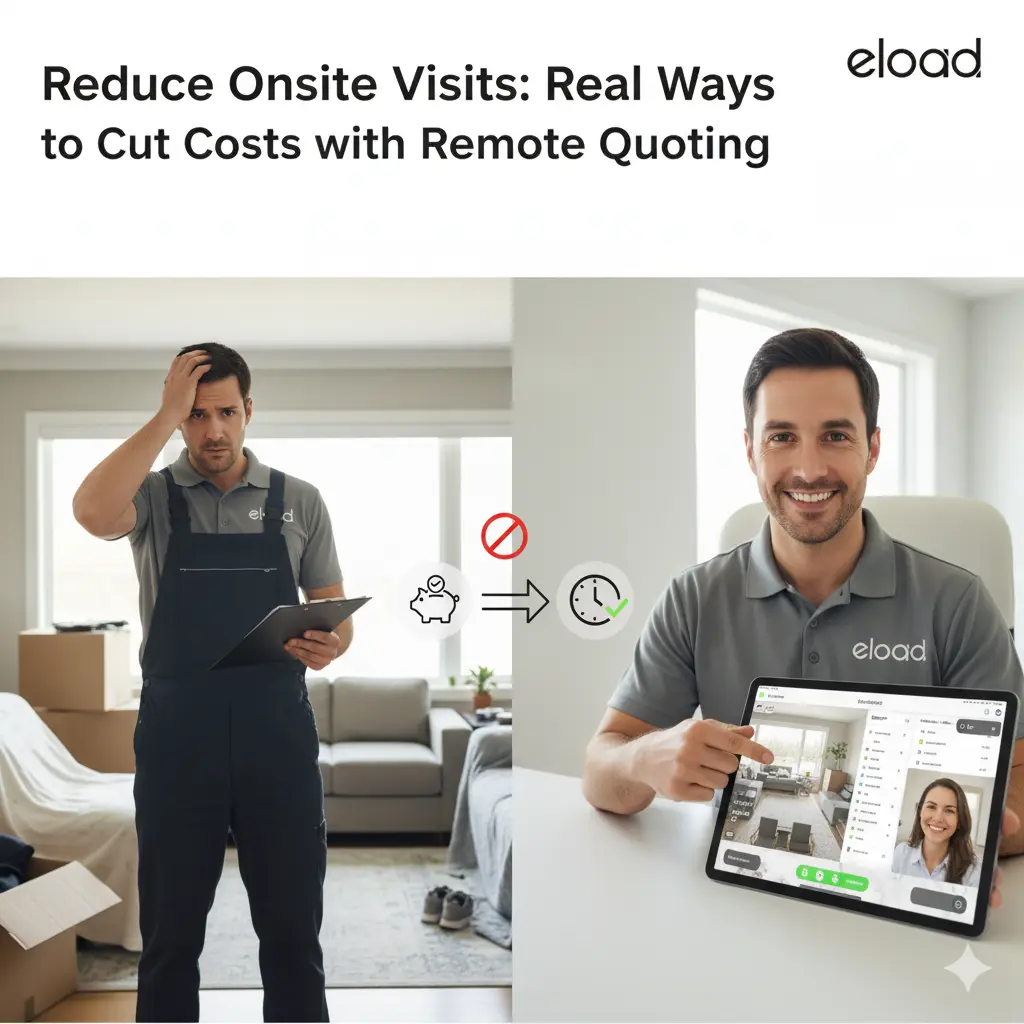Intro — why onsite visits are expensive
Onsite estimates create predictable costs: travel time, staff hours, and scheduling friction. For movers, countless hours spent on house calls reduce daily capacity and increase OPEX. For customers, waiting for an estimator delays decisions and raises the chance of surprise fees. Remote quoting—when done right—eliminates many of these costs while maintaining accuracy and trust.
The true cost of onsite estimates
- Travel & time: Estimators spend hours driving between jobs.
- Low capacity: A single estimator limits daily quote volume.
- Inconsistent pricing: Manual estimates introduce human error and disputes.
- Customer friction: Scheduling site visits adds friction to conversion.
- Hidden admin costs: Manual data entry and follow-ups create overhead.
Real strategies to reduce onsite visits (practical steps)
These are field-tested approaches you can adopt today.
- Offer remote quoting as the default option
Encourage customers to scan first; reserve site visits for complex or high-value jobs. - Give simple scan guidance
Provide short on-screen tips or a 30-second tutorial so users capture usable images and measurements. - Use itemized digital quotes, not ballparks
Line-item pricing reduces disputes and builds customer trust—make this available immediately after the scan. - Flag specialty items up front
Ask customers to mark pianos, antiques and fragile electronics during the scan flow so you can price them correctly. - Enable verification flows
For ambiguous scans, offer a short video call or a targeted follow-up rather than a full house visit. - Automate job cards for dispatch
Deliver clear specs, photos, and packing instructions straight to crews to remove guesswork on move day. - Bundle remote quotes with transparent policies
Publish cancellation, re-quote and specialty-item policies alongside the quote to avoid surprise charges.
Technical & operational checklist for reliable remote quoting
To make remote quoting work consistently, aim to implement:
- Clear mobile UI with scan prompts and example images.
- Camera-based dimensional estimation + AI validation.
- Itemized quoting engine (line items + packing types).
- Load optimization (2D/3D) to plan truck space.
- Webhooks/API to push job cards into dispatch/CRM.
- Audit trail (photos + timestamps) for disputes.
- Training for sales/dispatch teams to interpret remote quotes.
How Eload removes the guesswork (feature-to-benefit)
Use this quick mapping to explain the value to customers or internal stakeholders.
- Camera scan → itemized quote: eliminates manual measurements and reduces return visits.
- AI volume & weight estimation: increases quote accuracy for standard and bulky items.
- Dispatch-ready job cards: crews arrive with exact specs—no extra site visits.
- Load optimization: fewer trucks needed per day, lower fuel spend.
- Verification options: quick video checks for edge cases instead of full onsite calls.
- Audit trail: photos + item lists reduce disputes and save admin time.
Step-by-step pilot playbook for movers (30–60 days)
A short pilot proves remote quoting without disrupting operations.
- Choose pilot cohort (Week 0): 100–200 residential leads on non-peak routes.
- Train staff (Week 0–1): 1–2 sessions for sales + dispatch on using remote quotes and interpreting job cards.
- Launch (Week 1): Offer remote quoting as default for pilot leads; track adoption rate.
- Integrate (Week 1–3): Connect Eload job cards to dispatch via webhook or CSV export.
- Measure (Week 2–6): KPIs: estimate time, quote→book conversion, truck fill rate, number of onsite visits avoided.
- Iterate & scale (Week 6+): Adjust scan guidance, add verification steps, expand to more routes.
KPIs to track (examples)
- Estimate time per job (baseline vs pilot) — label as pilot if measured.
- Quote → booking conversion rate (uplift vs baseline).
- Number of onsite visits avoided per week.
- Truck utilization (% increase) and trips saved.
- Dispute counts and time-to-resolution.
(If you publish numbers, mark pilot-observed figures with (pilot result) and any modeled numbers as (assumption).)
Customer-facing tips to drive adoption
- Make remote quoting frictionless: SMS link + step-by-step prompts.
- Offer incentives (small discount or faster slots) for customers who choose remote quoting.
- Provide a clear “what to expect” line on the quote to reassure customers.
Common objections and how to handle them
- “What about fragile or large items?” — Flag and price specialty items during the scan; offer a quick verification call if needed.
- “I don’t trust remote measurements.” — Show audit photos, itemized line items, and the option for a short verification call.
- “Will crews still need to come earlier?” — With dispatch-ready job cards, crews arrive prepared; site visits become the exception, not the rule.
Conclusion — why remote quoting is worth the investment
Reducing onsite visits converts estimator hours into revenue-driving activities, cuts fuel and admin costs, and speeds up customer conversion. With the right technology, clear policies, and a short pilot, most moving companies can shift a large portion of quotes online without increasing disputes. Remote quoting isn’t just a convenience — it’s an operational lever that improves margins and customer experience.

